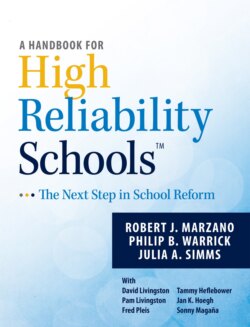Читать книгу A Handbook for High Reliability Schools - Robert J Marzano - Страница 17
На сайте Литреса книга снята с продажи.
Level-Appropriate Data Collection
ОглавлениеAs mentioned previously, schools should not only collect quick data for the level they are currently working to achieve but also for all of the lower levels they have already attained. However, we do not advise that schools try to collect data for levels higher than the one they are currently working on, because data for higher levels often cannot be collected by schools at lower levels. This is particularly true for levels 4 and 5. For example, a visitor to a school working on level 5 (that is, a school that has already achieved high reliability status at levels 1, 2, 3, and 4) might ask a student, “What level are you at in mathematics? Science? Social studies? English language arts? What measurement topics are you working on? What is your current score on those measurement topics? What are you doing to raise your score?” The student should be able to answer most, if not all, of these questions. However, a visitor who asked a student in a school working on level 2 the same questions would likely get a blank look. Because the school is not working on level 5, it is impossible to collect level 5 data there.
The hierarchical nature of our model is one of its most powerful aspects. Each level guarantees that a school is also performing at all of the lower levels. So, if a school is working on level 4 and has achieved levels 1, 2, and 3, it is guaranteed that the school has a safe and collaborative culture, effective teaching in every classroom, and a guaranteed and viable curriculum. By definition, working on level 4 means that lagging indicators for the first three levels have been met and the status of each is continually monitored. Each level supports the one above it and guarantees specific outcomes for those below it.
